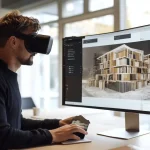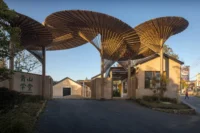In the ever-evolving world of architecture, staying ahead of the curve means embracing the latest technological innovations. Our toolkit has expanded beyond traditional blueprints and physical models to include cutting-edge digital tools that are revolutionizing the way we design and build. From virtual reality to AI-driven design software, these advancements are not just enhancing our creativity but also streamlining our processes.
Let’s explore how these innovations are transforming our approach to architectural design. Whether it’s through immersive 3D environments or predictive analytics, the new tech in our toolkit is enabling us to create more efficient, sustainable, and visually stunning structures. As we delve into these technologies, we’ll see how they’re shaping the future of architecture and pushing the boundaries of what’s possible.

Overview Of The Latest Innovations
Technological advances in architecture have revolutionized design processes. We now utilize several innovative tools that enhance creativity, efficiency, and sustainability in architectural projects.
Virtual Reality (VR)
VR immerses architects in their designs. It allows for real-time walkthroughs, providing a 3D visualization of spaces before construction. This technology enables clients to experience designs firsthand, facilitating feedback and revisions.
Artificial Intelligence (AI)
AI streamlines design processes by automating repetitive tasks. Machine learning algorithms can optimize building layouts for natural light, energy efficiency, and material use. AI-driven design tools predict structural issues, reducing errors and enhancing safety.
Building Information Modeling (BIM)
BIM integrates all aspects of a building’s lifecycle. It allows architects, engineers, and contractors to collaborate on a unified platform, ensuring accuracy and minimizing changes during construction. BIM improves project management and cost estimation.
Parametric Design
Parametric design allows for complex, efficient structures. Using algorithms and mathematical equations, architects can create flexible designs that adapt to specific constraints and requirements. This method supports innovative forms and sustainable solutions.
3D Printing
3D printing transforms architectural prototypes. It enables the production of precise models, reducing time and costs associated with traditional modeling methods. Large-scale 3D printing advances the construction of unique, customized building components.

Drones
Drones facilitate site analysis and surveying. They provide accurate topographical data, simplifying the planning process. Drones also monitor construction progress, offering high-resolution imagery and real-time updates, improving project oversight.
Augmented Reality (AR)
AR overlays digital information onto the physical world. Architects use AR to visualize designs within existing environments, aiding in spatial planning and design validation. Clients can see how proposed changes will look in real settings.
Sustainable Design Software
These tools assist in creating eco-friendly buildings. Software analyzes energy consumption, water usage, and material impact. Architects can design structures that meet sustainability standards, reducing the environmental footprint.
These innovations collectively transform architectural design, making it more adaptive and efficient. By embracing these technologies, we create visually impressive, sustainable buildings that respond to contemporary challenges.
Software Advancements
Advancements in software are revolutionizing architectural design. These tools enhance creativity and streamline processes in unprecedented ways.
Artificial Intelligence And Machine Learning
Artificial Intelligence (AI) and Machine Learning (ML) automate repetitive tasks. They analyze vast datasets to optimize building layouts for efficiency and safety. For example, AI-driven software predicts potential structural issues before they arise, saving time and costs in the construction phase. Furthermore, ML algorithms enhance material selection by predicting durability based on historical data.
Building Information Modeling (BIM)
Building Information Modeling (BIM) fosters collaboration. It integrates input from architects, engineers, and contractors within a single digital model. This enhances project management by improving accuracy. For example, clash detection tools identify and resolve conflicts between different building systems before construction begins, thus minimizing delays and rework. BIM also supports lifecycle management by providing detailed documentation for maintenance and future renovations.
Virtual Reality (VR) And Augmented Reality (AR)
Virtual Reality (VR) and Augmented Reality (AR) offer immersive design experiences. VR provides 3D visualizations and real-time walkthroughs, which boost client feedback and design revision accuracy. For instance, clients virtually explore a building before it’s constructed, making design adjustments interactively. AR superimposes digital designs onto real-world environments, assisting spatial planning. It helps stakeholders visualize how new structures will integrate with existing surroundings, facilitating better decision-making.
By leveraging these software advancements, we drive architectural innovation and efficiency, reshaping the industry’s future.

Hardware Developments
The tools shaping modern architecture have evolved rapidly, incorporating cutting-edge hardware advancements. Let’s delve into notable hardware developments influencing architectural design.
3D Printing Technology
3D printing technology is revolutionizing prototype production. Architects can swiftly create detailed scale models, saving time and reducing costs. For instance, firms use 3D printers to fabricate intricate models that would be labor-intensive if done manually. This technology also allows for rapid iteration, enabling architects to experiment with complex designs and materials before full-scale implementation. According to a report by MarketsandMarkets, the 3D printing market is projected to reach $34.8 billion by 2024, underscoring its growing significance in architecture and other industries.
Drone Technology
Drone technology enhances site analysis and construction monitoring. Drones provide accurate aerial data, enabling detailed topographical maps and real-time updates of construction progress. Companies like DJI and Parrot offer drones equipped with high-resolution cameras and advanced sensors. These capabilities help architects and project managers make informed decisions, optimize workflows, and ensure safety and compliance. A study by PwC indicates that commercial drone solutions can save the construction and engineering sectors up to $5.4 billion annually through increased efficiency and reduced labor costs.
Augmented Reality Hardware
Augmented reality (AR) hardware transforms how we visualize designs within existing environments. AR headsets, such as Microsoft HoloLens and Magic Leap, facilitate immersive experiences where virtual elements overlay real-world settings. This aids in spatial planning and decision-making, allowing stakeholders to see potential designs in situ. AR technology enhances client presentations and accelerates design iterations by providing an interactive and intuitive way to understand and manipulate architectural concepts. According to Statista, the global AR market size is expected to reach $198 billion by 2025, highlighting its expanding role in various industries, including architecture.
Sustainable Design Technologies
New technologies are revolutionizing sustainable architecture, delivering both innovation and efficiency. Let’s dive into some cutting-edge developments transforming the landscape.
Energy-Efficient Materials
Innovation in energy-efficient materials is crucial for sustainable design. Aerogel insulation, for example, offers excellent thermal resistance with minimal thickness, significantly reducing energy loss in buildings. Phase Change Materials (PCMs) store and release thermal energy during phase transitions, stabilizing indoor temperatures and decreasing reliance on HVAC systems. Recycled materials, such as reclaimed wood and recycled steel, not only conserve natural resources but also lower the carbon footprint of construction projects. These advancements in materials are key to achieving energy efficiency and sustainability in modern architecture.
Smart Building Systems
Smart building systems integrate advanced technology to optimize energy use and enhance comfort. IoT-enabled sensors monitor and adjust lighting, HVAC, and security systems in real time, reducing waste and improving efficiency. Automated shading systems adjust window coverings based on sunlight, cutting cooling costs and maintaining a consistent indoor climate. Advanced energy management systems analyze data from various sources to predict and adjust for energy demands, optimizing consumption patterns and reducing overall energy use. These systems make buildings more responsive to their environments, promoting sustainability while improving the user experience.

Industry Adoption
The architectural industry has rapidly adopted these technological innovations:
- Mainstream Use of BIM: Many firms now use BIM for its collaborative and precision-enhancing capabilities, streamlining project workflows.
- AI and Machine Learning: These technologies assist in optimizing building layouts and predicting potential issues, improving overall design safety and efficiency.
- 3D Printing and Prototyping: Architects widely use 3D printing to quickly produce detailed models, facilitating rapid design iterations and client feedback.
- AR and VR Tools: The use of AR and VR for design visualization has become standard, enhancing client presentations and decision-making processes.
Industry adoption shows a clear trend towards embracing advanced tools to meet modern challenges in architecture, promoting innovation and sustainability.
Conclusion
Architectural design is undergoing a remarkable transformation thanks to cutting-edge technologies. From VR and AI to BIM and 3D printing we’re witnessing a shift towards more efficient and innovative practices. These tools not only enhance creativity but also streamline processes and improve sustainability.
As we continue to integrate these advancements into our projects we’re setting new benchmarks in design and construction. The future of architecture looks promising with these technologies driving us towards smarter and more sustainable solutions. Let’s embrace these innovations to shape a better-built environment for generations to come.
- 3D modeling for architects
- advanced design technology
- AI in architectural design
- Architectural Design Innovations
- architectural design technology
- architectural technology trends
- architecture CAD software
- architecture design innovations
- Architecture Design Software
- architecture design tools
- architecture tech tools
- architecture visualization tools
- BIM software for architecture
- digital tools for architects
- innovations in architecture design
- latest in architecture technology
- modern architectural software
- VR in architecture design















1 Comment